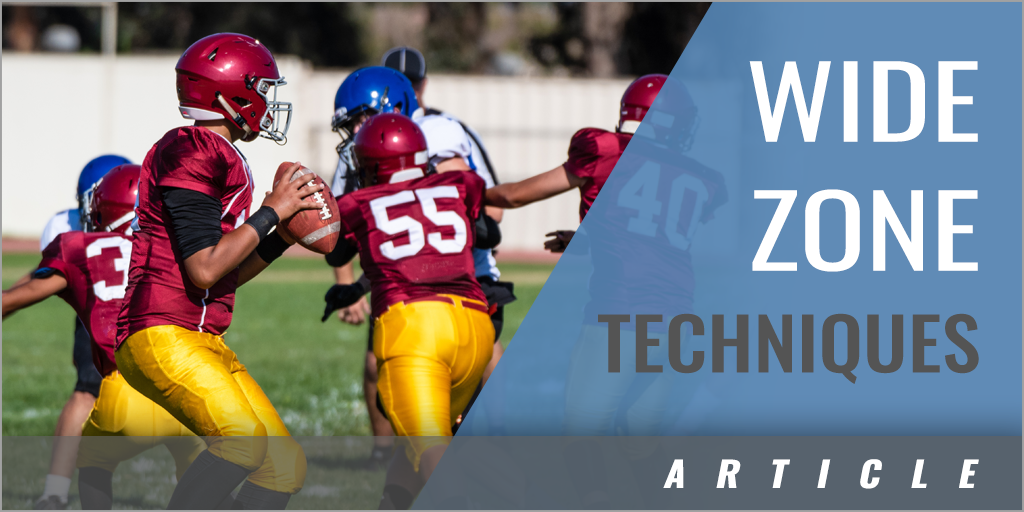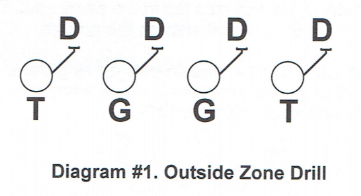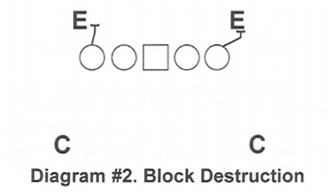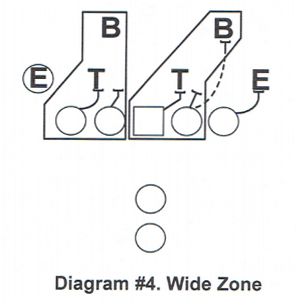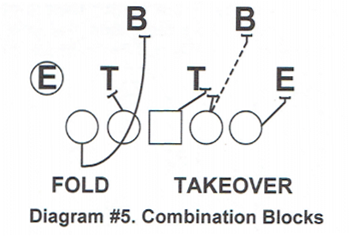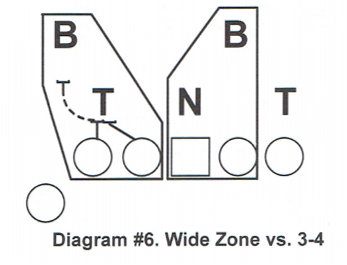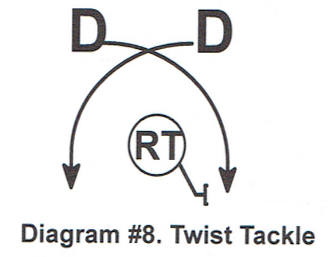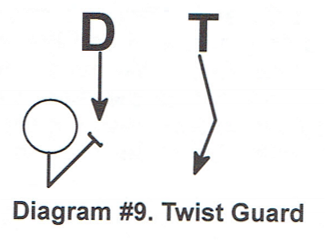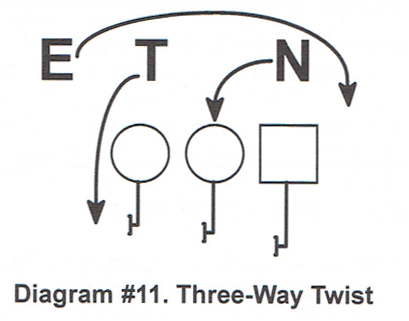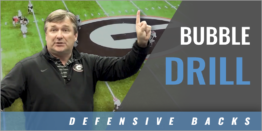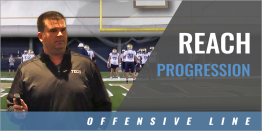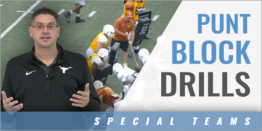|
By: Alex Mirabal - Univ. of Oregon Originally Published in: 2020 Nike Coach of the Year Clinic Manual - by Earl Browning Provided by: Nike Coach of the Year Thank you very much. It is good to be here. I am going to talk about the wide zone and how we do it. This is not the answer, but it is just the way we do it. When we pass set, some guys are angle set and some guys are vertical. We are in the angle set camp. We will vertical set on occasion. In the run game, we are a double under team with our hands. That does not mean we are right, but that is what we believe in. We used the double under in the inside zone and now we are starting to use it in the wide zone. We feel like it has helped and benefited us in making that play more effective and more efficient. That is what we believe in. I am not trying to sell you on the technique, but that is what we do. At our place we do not talk about getting our hands inside, we talk about getting them under. To demonstrate the double under, I use a player holding a large medicine ball. The double under move strikes the medicine ball at the bottom of the ball and forcing an upward movement. This is a forklift technique. When you strike with the double under you create brackets. When you have brackets you have strength. leverage, and power. This is what we use on the inside zone. We have an inside zone progression, but we are not here to talk about that. But what we are going to talk about comes from this. I was a high school coach for 15 years and used this block. You can use it in high school. It is not something that is only used at the college level. The defensive linemen we face are better than our offensive linemen. The defensive linemen you face are better than your offensive linemen. In our offensive line, we do not use the double under as an exclusive block. We also use the techniques we use on the Crowther sled. We use the double under technique using one hand in a backside cut off block. Covered Offensive Lineman
The rules for the covered linemen on the outside zone are through the crotch. The backside hand goes to the sternum of the defender. The face goes to the play side defender's armpit. Those are the three things we talk about and are our buzz words. When I say that. it means something to the offensive linemen. For the sake of the lecture, I am going to demonstrate a technique for a right guard on a wide zone left. The defender is aligned in a 2i-technique. I am going to step with my backside foot (right) through the crotch of the defender. He is going to use a single under move with his right arm into the sternum of the defender. The last move is to get the face to the play side armpit of the defender. On the wide zone, the target is the play side armpit. It does not matter if I am the right or left tackle. They both have the same target if they are both covered. These are not fancy rules, but they work. When I drill this, I have four offensive linemen and four medicine ball holders. (Diagram #1)
The ball holders are aligned to the right of the offensive linemen. The alignment on the first linemen is a 5-technique, the two inside linemen are blocking 3-techniques and the fourth lineman is blocking a 5-technique. We all are stepping to the right. They are all in right-handed stances. The reason we use medicine balls is so we can really punch them. If you use a hand dummy. it is going all over the place. It is more lifelike with the medicine ball. For the medicine ball holder. we want one hand around the ball and the other hand and arm over the top of the ball. That keeps the ball from being jammed into the face of the dummy holder. The medicine ball has to be the soft medicine balls. The hard ones will tear up the hands and wrists. On the crotch step, we want to run through the crotch. We do not want to run around it. Continue to run through the crotch. We want to attack the cylinder of the body. As we go wider, we want to lean into the defender and continue to run the knee into the crotch. I hate numbers. There is not one drill with the offensive line where I refer to something as 6-inches. If you tell me 45-degrees, I have no idea what that means. We use what I refer to as common sense footwork. I do not fool with numbers. I am not saying we are right, just that is how we do it. On the other side, I have four offensive linemen in a left-handed stance doing the same thing. The medicine ball holders are on the right side of those linemen. They are using the same technique going in the same direction. This is blocking a zone play to the right. They are stepping through the crotch with the backside foot. They are using a one-armed under into the sternum and working the face to the play side armpit. After we do that, we reverse the direction. We do the same thing going left. We then use the same technique stepping with the right foot into the crotch of the defender, right hand under punch to the sternum. Face to the play side armpit. We are working on footwork at the same time. The play side foot is almost a tap in the same spot. We want to get the second step on the ground. The next thing is one-on-one running the wide zone. Every Wednesday we have what we call block destruction. (Diagram #2)
If we work pass blocking, the defender works pass rush. We are going 1's against 1 's. We take the offensive line and split them in half. I take the right side and Coach Heyward takes the other side. Coach Cristobal stands behind the defense and signals the play to be run. D-Line coaches are natural born cheaters. On every play, the defense is aligned offsides. I do not say anything because it is team. I coach for Oregon and we all get along. This is a team game. Also, this is a run only drill. The defense does not have to worry about the pass rush. They tee off on the offensive linemen. That is fine. It makes it harder on us, but it makes us better with our technique. We go two tackles against two defensive ends. It is not a full line drill. The next part of the drill aligns the offensive guards against 3-technique defenders. We work the drill we worked in dummy practice against good football talent. We work against outside linebackers as well. They are coached not to get reached. We use that technique against them. The offensive blocker is going to threaten the defenders outside and push him wide. The running back is running outside zone and not a stretch play designed to go outside. The running back is going to run wide and cut up. The linebacker's width works for the offense. It does not matter what game we have coming up we do this drill every Wednesday. This is a five minute drill. We are going from our individual drill into a live blocking drill against our best defensive linemen. We work the on one side and the 2's and 3's on the other side. If we are going to Oregon State and not using the power play, we will not work it in this drill. We go from this type of drill to the 7-on¬7 inside run drill. The secret to any offensive lineman's block is for his feet to not stop. He has to run his feet the entire time he is engaged with a defender. When the defender tries to escape is when the feet have to really come alive. In the 7-on-7 drill, we are working with four down linemen, two linebackers, and a strong safety on defense. (Diagram #3) On the offensive side. we have the five offensive linemen and a quarterback and running back. If we align in a pistol set with a tight end, our running back's landmark is the tight end. If there is no tight end the landmark is the ghost tight end. If we are shotgun, it is three steps back to the handoff. The quarterback reads the last hand down on the line of scrimmage.
i will talk about the uncovered lineman in a minute. We are working the drill with the right guard and tackle. The backside guard and tackle are working a combination for the 2i-technique and the backside linebacker. We have to practice several techniques with our guards and tackles. The guard has to work against a 3, 2, and 2i-technique. The technique is the same for all three techniques, but the footwork is slightly different as to the angles. We are still using the inside step to the crotch with a single under to the sternum. and the head to the play side. The running back has to make his decision where to run the ball on his third step. He is reading the triangle of the 3-technique, 5-technique, and the linebacker. When the 3-technique widens, he is going to take it inside of him. In our first game against Auburn, we ran this play. (Diagram #4) The play was wide zone right. The right guard had a 2-technique defender aligned on him. He takes his outside foot, steps up and down with it, and steps with the inside foot into the crotch of the defender. The right tackle is working a man block on the defensive end. He is using this technique and has no help.
The center's technique, I will cover in a minute. He and the right guard are in combo to the play side linebacker. The left guard and tackle are in combo to the backside linebacker. We read the outside man on the line of scrimmage. I am not the coordinator. I do not call the plays. My job is not to suggest plays. My primary job is to teach fundamentals and techniques so we can get the job done. The combination block by the center and right guard becomes a double team. Too many people leave the double team too soon. The guard does his block with his outside arm free. He has his inside arm on the sternum. but the outside arm is free. When the guard blocks the 2i-technique his technique changes with the knee to the crotch. We want to step with the inside foot slightly wider. Instead of the crotch, we want to step on the defenders' outside toe. So many coaches teach to step outside and lock the inside arm on the 2i-technique. If you tried to do that to Big Kat Bryant from Auburn, he would break your elbow. We want to pick the right foot up and set it back down. We step with the inside foot to the outside toe of the defender. We use the one arm under and keep the outside arm free. The center has a three-step decision to make. Does he double team with the guard and knock the defender out? (Diagram #5) Does he take over the block and let the guard climb? Or does he climb? If the center decides to take over the block, he tries to get his face to the play side armpit of the defender. That is clinic talk. He tries to do that, but he blocks him any way he can. The backside guard and tackle can double team the 3-technique defender up to the linebacker or they can fold block it.
The guard blocks out on the defender and the tackle folds to the inside and blocks the linebacker. We love to fold block the backside. That is bringing man principles to zone football. We like to fold but we do not do it every time. You as the coach cannot call the fold. The minute you call it the defender will align in a 2i-technique and you are screwed. You have to allow the players to make that call at the line of scrimmage. When they see it, they give the fold call whatever it is. That is a change in the technique, and we do not do it all the time. It has to be a certain look. The tackle pulling around the guard uses an open pull. When the tackle comes around on the fold block, he goes back to his technique on the linebacker. He is stepping down the crotch, back hand to the sternum. and face to the play side. The linebacker is going to move with the ball action. The tackle will find him on the other side of the center. That is the reason for the open pull. It is more like a trap block. He is not turning up to block the linebacker. he is pursuing him to the play side. I am going to show one inside zone play to illustrate the difference. We will fold on the backside with the inside zone also. However, when the tackle pulls around the guard. he must use a skip pull instead of an open pull. If the tackle open pulls, the linebacker will come downhill and knock the tackle back into the backfield. When we skip pull, I teach a "stop open" technique. The tackle slides his outside foot to the inside foot and steps off with the inside foot. Against the 3-4 defense. nothing changes for us. We are still using the same techniques. (Diagram #6) The center and backside guard are in a combination block on the nose and backside linebacker. However. the center can give a call to the guard which tells him that he is going to block the nose by himself. That releases the backside guard to pull around the center and block the linebacker that way. If the center feels that the nose is playing a drag technique, he calls the guard to pull around. We call that a bracket call.
We had a tall right tackle. When the play was run away from him. he used an arm over technique on his cutoff block. We do not teach it to everyone because everyone cannot do it. The scheme we run depends on the type of defensive linemen we play. We have different ways to block. Uncovered Offensive Lineman
The uncovered lineman's first step is dependent on the play side linebacker. If he is wide. we have to open it up. The first decision that the inside blocker has to make is whether he can take over the block. If the defender is fighting to get to the outside, which prevents the tackle from reaching him, the inside blocker pushes him to the outside and climbs. If on the third step, the uncovered lineman can take over the block, he pushes the other blocker off the block and takes over the block. If the defender widens off the snap, the blocker goes one, two, and three. and climbs to the linebacker. The thing the uncovered lineman does not want to do is knock the other blocker off the block. With the center and right guard working a combo block on the 3-technique, the center has a three-step decision. (Diagram #7) The center comes off and sees the 3-technique widen. He gets his hands on him and shoves him wide onto the guard's block. He then climbs to the linebacker.
I want to cover some pass blocking techniques before I stop. I think it is hard for the linemen to communicate a twist stunt after the snap. When we start to teach, we work one verses two defenders. In the drill, the right tackle has 3-technique to his inside and a 5-technique on his outside shoulder. This is one of those situations where we will vertical set. The tackle wants to get his hands on the 3-technique and watch the 5-technique. (Diagram #8) He is setting off the 5-technique defender, but he must feel the 3-technique. When the 5-technique defender does not come up the field, the tackle takes the 3-technique defender coming to him.
If the 5-technique defender crashes inside, the tackle takes him until the guard comes out. With that, he goes back to the 3-technique coming outside. We have the same 2-on-2 drill with the guard. He is going to set on the 3-technique. (Diagram #9) He has to see the 5-technique. If the 5-technique goes up the field, he blocks the 3-technique. If the 5-technique comes inside he takes the outside rusher and the tackle takes the inside rusher.
In the next drill, we put 2-on-2. We have the guard and tackle and two defenders. (Diagram #10) We start with a 3- and 5-technique. If the 5 goes in, the tackle bumps the guard over to the 5. The tackle backs up and takes the 3-technique.
If they both rush straight, there is no problem. If the 3 goes outside. the guard bumps the tackle onto the 3 and picks up the 5 coming inside. If the center and right guard have a nose and 3-technique defender, they have to switch off on the twists. If the nose loops to the outside, the center bumps the guard over and plays the 3 coming back to the inside. If the 3-technique goes to the outside, the guard wants to knock the defender out onto the block of the tackle. He backs up and takes the 5 coming inside. We do these drills every day. We do the same thing with three rushers. (Diagram #11) With the nose 4i-technique and 5-technique defensive end. The 5 rushes upfield and the tackle takes him. The nose charges outside and the center bumps the guard onto him. He backs up and plays the defensive end coming around from the outside.
We work these pass rush twists daily. I appreciate your time. I am not saying the way we do it is the right way, but we are committed to it. We believe in it. Whatever you believe in, sell it to your kids and put it on tape. If you put it on tape show it to your kids. If you do not do that than individual drills will become drudgery and you will not get any better. Learn how to block the 3- and 5-techniques. Thank you I appreciate it. |
